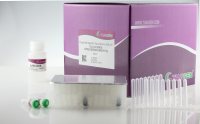Characterization of DNA Condensates by Atomic Force Microscopy
互联网
572
In recent years, interest in in vitro DNA condensation has been revived by efforts to develop vectors for nonviral gene therapy (1 ,2 ). One of the critical elements for successful and versatile delivery of specific genes into targeted cells is that DNA vectors of several kilobase pairs must be compressed and packaged into small particles. Ideally, the size of these particles should be similar to that of viruses, typically less than 100 nm in diameter (3 ,4 ). It is well known that several classes of multivalent cations can be used to condense DNA in vitro to form well-defined structures, particularly toroids and rods (5 ,6 ). Because of its simplicity, this type of in vitro condensation of DNA has become a widely studied system for investigating mechanisms of DNA condensation.






